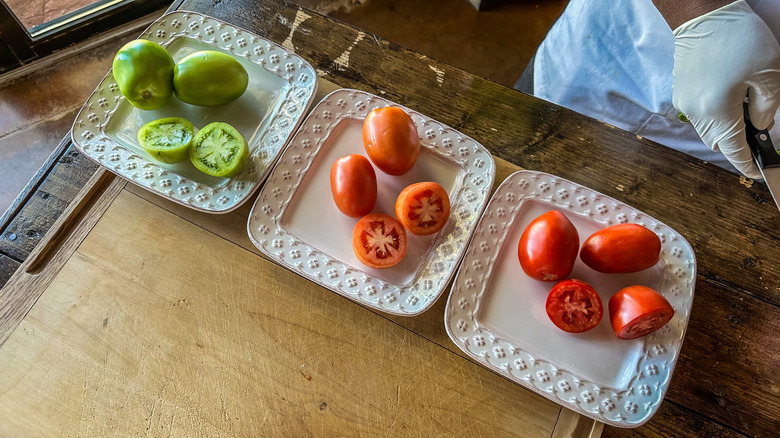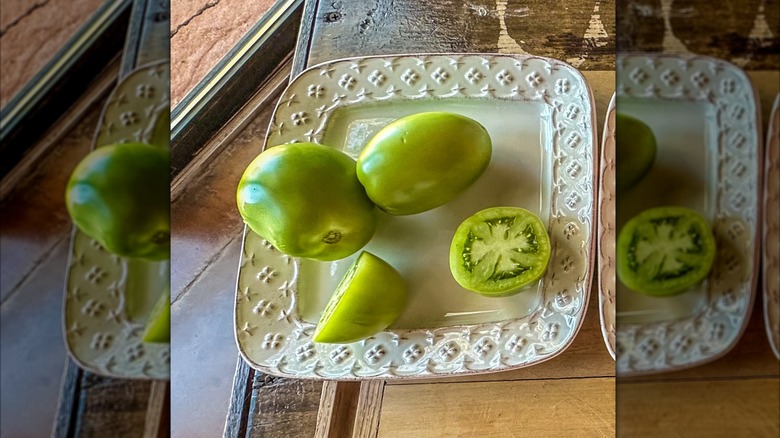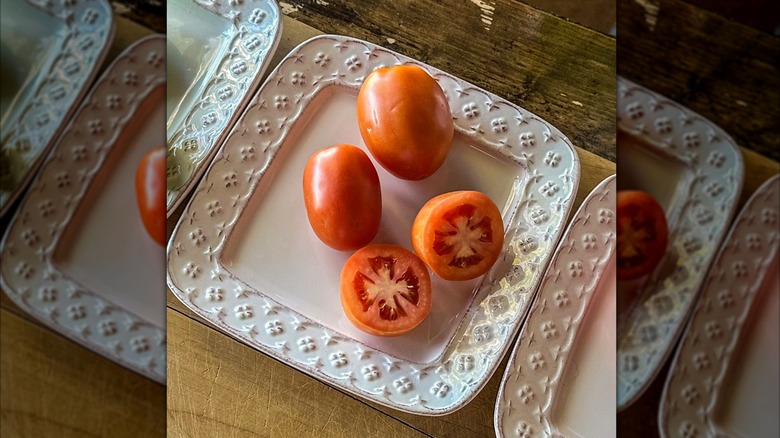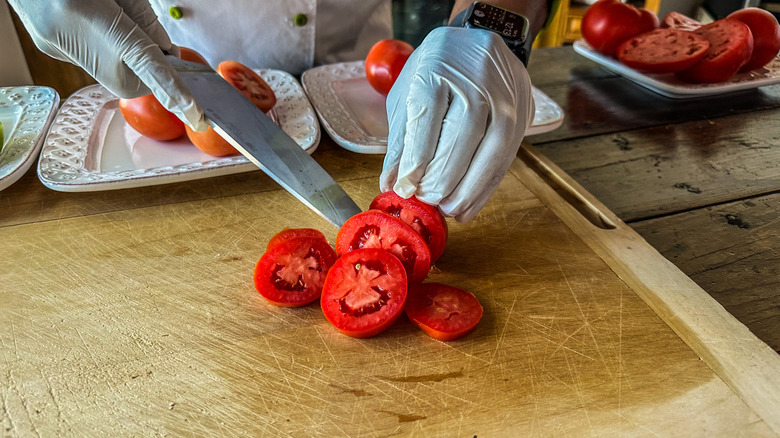The 3 Stages Of Tomato Ripeness And The Best Ways To Eat Each
The humble tomato, like any other fruit or vegetable, has a lifecycle. As it spends time growing and maturing in the sun, it reaches different levels of ripeness, and it's that final stage of ruby-red perfection that many of us are so accustomed to seeing in the store or in the garden right before putting in a salad or sandwich, working into a sauce, or simply enjoying with nothing more than a sprinkle of good sea salt.
However, unlike other fruits and vegetables, those early and midway ripeness stages aren't prohibitive when it comes to partaking in this tasty vine-ripened treat. In fact, an early-stage tomato can be just as useful as a fully ripened late-stage tomato, and depending on what you're making and how you're making it, using a tomato that's only partway through its ripening cycle may end up working to your advantage.
We had the opportunity to taste tomatoes at three different stages of ripeness with Chef Terrence Tookes, Executive Chef at Olive Garden, and some members of the Neil Jones Food Company, to learn about these stages and why it's not just the fully ripened red tomato that deserves all the attention. If you're a lover of tomatoes but unsure where to begin when using them at different stages of ripeness, consider this your guide to uncovering all the versatility this impressive fruit has to offer.
Green tomatoes
Whether you're buying your tomatoes at the grocery store, farmers' market, or even from your own home garden, you're probably familiar with the green tomato. This tart, crunchy version of the Roma tomato is simply in its earliest stage of the tomato ripening journey, and for the culinary team at Olive Garden, these early fruits are just as important to the sauce as the rest of the ingredients, as they offset acid and sugars in the final product.
Michael Dunn, Director of Product Development for Neil Jones Food Company, sees the green tomatoes as essentially the glue that holds the sauce together. Because of the raw pectin found in the green, unripened fruit, more pectin goes into the tomato puree to hold onto the liquid from the ripe tomatoes, meaning the culinary team can use fewer gums and starches. The final result? A more viscous, luxurious sauce that drapes your noodles rather than falling through the cracks to the bottom of the bowl.
Just because green tomatoes aren't as often used as their more ruby red ripened counterparts, doesn't mean there isn't any use for them. The firmness of these tomatoes makes them ideal for breading and frying, like for a fried green tomato, as they can hold their shape while sizzling in the hot oil without falling apart. Sticking with the appetizer theme, use green tomatoes instead of tomatillos for a zippy salsa verde with plenty of onion, jalapeno, and avocado for a creamy finish.
Breakers
More ripe than a green tomato but not quite at peak ripeness, breakers are the in-betweeners. While you may think these yellowish-red tomatoes are simply a rest stop on the way to the final product, they end up being just as useful as every other tomato in the sauce-making process. Like the green tomato, the breakers still have some firmness to them for a crunchier bite, as well as more pectin to help with the sauce's viscosity. However, because the breakers have had more time to ripen in the hot sun, they've developed more flavor than the green tomatoes. Expect a bite that still has a toothsome note to it, but a sweeter, juicier, and more developed flavor.
Despite not being at full ripeness, a slightly firm and flavorful breaker tomato can be put to good use in a variety of recipes. Start with the world's most perfect sandwich, the BLT, for instance; the firmness and slight acidity of the breaker tomato make it ideal to stand up with a few slices of thin and crispy strips of bacon. Rather than have each bite be a drippy, juicy mess, the breakers hold their shape for a uniform, well-balanced bite each time. Additionally, breakers are ideal for use in a salad like a panzanella, which benefits from just a bit of moisture from the tomatoes and olive oil to soak into the crusty bread.
Red tomatoes
It only makes sense that once you've gone through the progression of early-stage and mid-stage tomatoes, you will reach the final product: The red tomato. Unlike the first two, the red tomatoes have reached peak ripeness, and it's this ruby red fruit that you're most likely to buy. Chef Terrence Tookes and his team at Olive Garden are counting on these red tomatoes to have reached peak perfection; they're the lifeblood of the salads and soups, as well as the freshly-made marinara and meat sauce. The flesh of the red tomato is far juicier and softer than the greens and the breakers, and that fully vine-ripened fruit provides more richness and a deeper, fresher tomato flavor to the final product.
Since red tomatoes are what we're most accustomed to cooking with, there are many recipes for getting the best out of them and letting their flavor really shine. Take the caprese salad, for example. Glistening with the sweet, bright flesh of the freshest tomatoes you can find, this simple creation only requires a handful of ingredients, but it's the tomato that ends up doing the most work flavor-wise. Of course, a delicious quick tomato sauce benefits greatly from the use of chopped fresh tomatoes. For the most straightforward example of that true tomato flavor, a ripe tomato is ideal for roasting with nothing more than a drizzle of olive oil and a healthy sprinkle of salt and pepper to draw out that perfect balance of sweetness and acidity.



